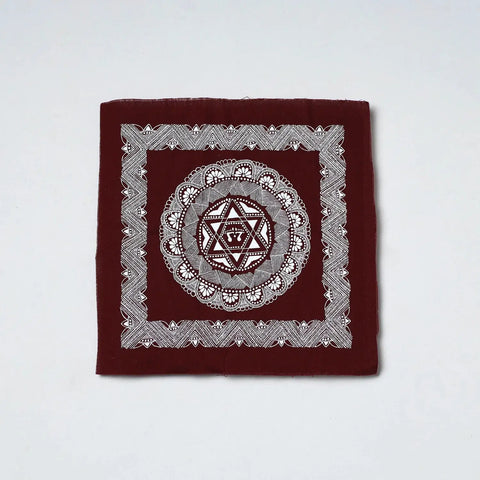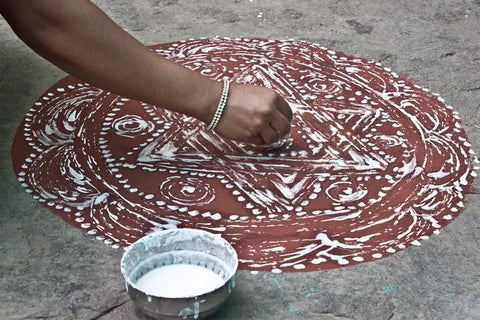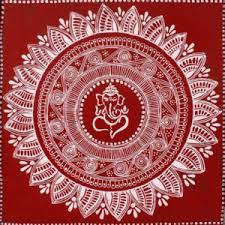Aipan folk art stands out as a captivating display of creativity and cultural heritage. This unusual form of folk art of Uttarakhand is majorly done on floors and walls. Featuring different designs and patterns, Aipan paintings have come a long way.
If you love exploring various traditional handicrafts in India, then this blog is for you. Through this blog, we’ll take you on a journey explaining what is Aipan art, its history, its types and much more. Come read along with us!
What is Aipan Art
The Kumaon region of Uttarakhand is home to the ritualistic folk art known as Aipan. The word Aipan is derived from the Sanskrit word Lepna, meaning plaster. The Kumaoni Aipan art is mostly drawn on joyous events, festivals, and even funeral rites. It is also believed that this folk art of Uttarakhand has the power to ward against evil. Earlier, the art form could be seen on the walls and floors of homes, but today it is found in various items of apparel or home decor pieces.
Aipan folk art is inspired by the religious belief of people who practice this art. The patterns typically feature flowers, geometric patterns, conch shells, the swastika, goddess footsteps, and god and goddess images.
Aipan art is unique in that it always begins and ends with a dot. The dot at the beginning stands for the centre of the universe and is positioned in the centre. All of the other lines and patterns radiate out from the centre, demonstrating how the environment is changing.

History & Origin of Aipan Art
Aipan folk art flourished during the rule of the Chand dynasty. It is believed that the traditional Aipan art was first practised in the Kumaon region and then, later on, moved to other areas of the region, as the communities and individuals who practised the craft moved. In the past, traces of traditional Aipan art may be seen on the walls and floors of homes. However, throughout time, it has also started to appear on several household items and garments.
The Kumaoni Aipan art got its Geographical Indication (GI) Tag in September 2021. (1)
Process of Aipan Art Of Uttarakhand
During ancient times, to make the space dust-proof, the floors and walls were first cleansed with cow dung liquid (cow dung combined with water). However, due to the advent of cemented walls and flooring, cow dung solution is no longer used in all homes in the present era.

Geru (wet mud), which is red in colour, is used first and foremost to prepare a flat surface. Cooked rice is ground with water to create the white paste known as bisvar, which is used to create designs on the surface. These days, however, many houses also employ red and white acrylic hues and synthetic enamel paints. Aipan painting is typically practised by women using the fore, ring and middle fingers.
It all begins with the bindu, a solitary dot or point of enormous significance. The entire cosmos is thought to have originated from this dot and will ultimately collapse into a single point. A six-pointed star is created by the two triangles that surround this dot. The upper triangle stands for Shiva, while the lower triangle is for Shakti or Parvati. Circular patterns that powerfully evoke the home, the natural world, riches, and other aspects of life surround these. These have 'rekhas', or lines, enclosing them on all four sides, signifying the earth. The picture also features other natural elements like conch shells, kalash (an urn), and footprints.
You Might Like Reading:
Kalighat Painting - The Folk Art from Bengal
The Madhubani Painting Heritage
Folk Art Map of India: 10 Gorgeous Art Forms That Won the GI Tag
Materials Used In Aipan Art
- Cow Dung - Cow dung is used as a foundation coat before applying the red coating of geru.
- Geru - Before painting the Aipan design, a red coloured solution of Geru was poured to the floor as a basis.
- Rice Paste - Aipan designs are painted using a water and rice paste solution.
- Brush - The themes from Aipan folk art are painted using a painting brush. A basic bamboo stick with a piece of cotton wound around it is sometimes used to create handcrafted brushes.
Types Of Aipan Art Of Uttarakhand
Kumaoni Aipan art is drawn in various ways and occasions, some of them are listed below:
- Saraswati Chowki - Used to mark the start of a child's formal education.
- Chamunda Hast Chowki - It is designed for ceremonial or sacrifice fires
- Nav Durga Chowki - Pujas are performed on such chowkis. There are nine dots in the artwork, each of which stands for one of the Nav Durgas.
- Shivarchan Peeth - This Aipan design is drawn while worshipping Lord Shiva, the reigning deity.
- Acharya Chowki - The pandit or guru is valued more highly than the bride in mainstream Hinduism. The chowki is made for such gurus.
Some other significant types of Kumaoni Aipan Painting Chowki are Surya Darshan Chowki, Asan Chowki, Durga Thapa, Jyoti Patta, Lakshmi Yantra, and Janeyu Chowki.
Aipan Art Today
The distinctive Aipan folk art began to disappear over time, currently it is not as highly practiced as was earlier. However, initiatives are taken by locals and government to restore the beauty of Aipan art of Uttarakhand.

You Might Like Reading:
The Mesmerizing World of Tanjore Art
The Pictorial Narratives of Cheriyal Paintings from Telangana
Bhil painting : The Tribal art of India
Final Words
With its vivid colours and intricate motifs, Kumaoni Aipan is a wonderfully entrancing art form. The traditional Aipan art creates a stunning visual extravaganza that catches the attention right away using Red Geru and White rice powder.
Each design on Aipan is a monument to the rich traditions and customs of the area, and what makes it unique is its versatility, with different varieties made for different events and celebrations.
If you too want to embrace the beauty of the versatile traditional Aipan art, iTokri has got you covered with its amazing and authentic collection of Indian handicrafts. Scroll on our website and let your love for our cultural and traditional handicrafts flourish.
Frequently Asked Questions on Aipan Art Of Uttarakhand
-
What are the key characteristics of Kumaoni Aipan art?
The traditional Aipan art is made using last three fingers of right hand and Aipan design starts form a dot and end on a dot.
-
What are the different types of Aipan designs?
Different types of Aipan designs are Saraswati, Chamunda, Acharya, Shivcharan, Asan, Durga Thapa and more.
-
What materials are used for Aipan folk art?
Geru(Red clay), brush, rice paste and cow dung are majorly used in creating Aipan folk art.
 Verified Purchase
Verified Purchase
















Tina Jones
Liquid error (sections/custom_blog_posts line 652): The format option 'month_day_year' is not a supported format.
That was fascinating, + beautiful. New to me. I love the kantha pieces too. I want to try this. Inspiring.